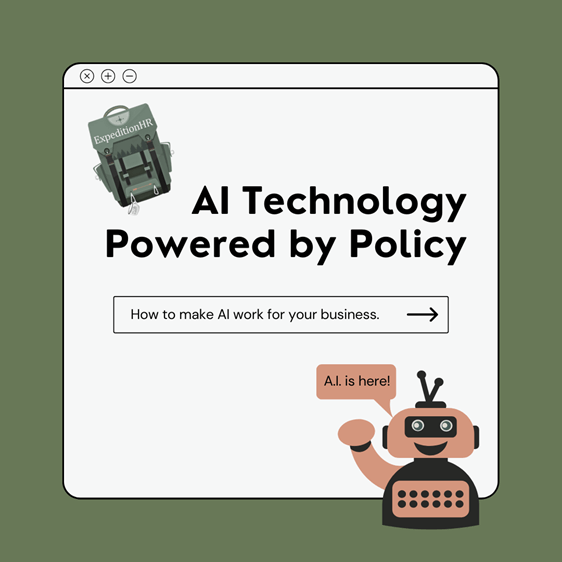Authored By: Amanda Kevin, Founder of ExpeditionHR
Software and technology-based tools have continued to evolve our working environment by enabling us to be more effective, streamlining cumbersome processes, all while keeping us organized. In most cases, technology supports our operations and makes our tasks overall more enjoyable to complete. While we find safety and familiarity in using these tools, the question remains, can we do the same with Artificial Intelligence (AI)?
There’s no question that AI offers numerous benefits in terms of efficiency, accuracy, and innovation, but it also presents challenges related to fears of job displacement, information bias, privacy invasion, and ethical dilemmas.
So, what’s an employer to do when they want to empower employees to utilize the power of AI, but in a way that won’t jeopardize the company’s ethics?
Create User Guardrails + Get Specific
Creating clear guidelines and expectations for employees on how they can use AI as a tool at work will help them understand where it is and isn’t appropriate to use the technology. Based on the types of roles you employ, make sure the AI policy is relevant. For example, if you have artists on your team, AI can certainly help boost creativity, but they should have specifics on how they should and should not use AI to create generative and conceptual art. If you have customer service representatives on your team, AI can be very helpful in creating messaging as they respond to customer requests, but be specific about how messaging should be tailored to each individual customer to keep your services unique.
Review Security and Privacy Policies
Before allowing employees to use any kind of AI, it’s important to evaluate the security of the tool by reviewing their security features, terms of service and privacy policy. It also could be helpful to check into the reputation of the tool developer and any third-party services used by the tool. You should also identify when and where it is safe for employees to upload or share any data that could potentially be confidential or proprietary to your business.
Develop Best Practices
Ideally, you’ll want to create a list of ways that AI can and cannot be used, and provide best practices to employees on how to stay within those practices. It will also help employees self-regulate as they use the tool, to know when they might be tip toeing into unsafe practices.
When you create the right structure and policy, AI can be used safely and effectively to enhance your team’s creativity and help boost productivity. Looking into the face of change and evolving technology like we’re experiencing today, I hope you can find confidence and excitement in bringing these new powerful tools to your team, and in a way that feels safe and regulated for your business.
—
 Amanda Kevin is the Founder of ExpeditionHR. Leveraging her 10+ years of experience building HR functions for several high growth startups, her passion is in creating a fulfilling and meaningful employee experience. Through alleviating compliance stressors, creating policy that upholds workplace culture, and creating a work environment that professionals will be drawn to, ExpeditionHR will guide small business owners towards fulfilling their wildest dreams.
Amanda Kevin is the Founder of ExpeditionHR. Leveraging her 10+ years of experience building HR functions for several high growth startups, her passion is in creating a fulfilling and meaningful employee experience. Through alleviating compliance stressors, creating policy that upholds workplace culture, and creating a work environment that professionals will be drawn to, ExpeditionHR will guide small business owners towards fulfilling their wildest dreams.

